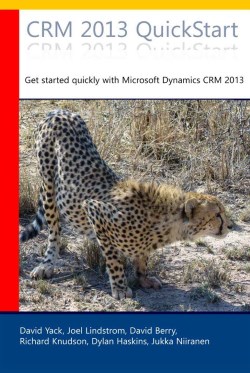Related sites:
Newsletter: Perspectives on Power Platform
Company: Niiranen Advisory Oy
 The CRM 2013 Quick Start book is a first look at Microsoft Dynamics CRM 2013 and all the new features that have been included.
The CRM 2013 Quick Start book is a first look at Microsoft Dynamics CRM 2013 and all the new features that have been included.
In the CRM 2013 Quick Start you will find details that can help administrators, customizers (functional consultants) and developers; not to mention power business users wanting to know all the details the admin never tells them. If you run CRM in the cloud or sitting in a server room at your office the information is useful.
This book is targeted to someone who has some CRM prior experience. By that we simply don’t spend any time explaining the basics of Microsoft Dynamics CRM from a beginner’s point of view. That said, the information in this book would still be useful on your journey to become proficient
For more details on what to expect in the book, here’s a summary of the 11 chapters included:
Chapter 1 – Hello I’m CRM 2013
Microsoft Dynamics CRM 2013 is a major release building on the strong foundation of CRM 2011. From the user experience to platform capabilities CRM 2013 has changes that are targeted for everyone as users, customizers, IT Pros, and developers. In this chapter we give you a 50,000 foot tour of what’s new.
Chapter 2 – The User Experience
Before you can build solutions in CRM 2013 you should learn how the new user experience works. In this chapter we will dive into the new experience and break down all the key changes so you are ready to start thinking about customizing it.
Chapter 3 – Customizing CRM Forms
The 2013 user experience requires rethinking how we customize forms. From the new layout options, new controls and even new form types we have a lot to talk about. We also can’t forget you might have CRM 2011 forms and want to know how to move them forward into this release.
Chapter 4 – Security Model Changes
Today’s global business challenges the traditional organization structure as people form dynamic teams to work on individual opportunities or other data in CRM. CRM 2013 addresses that with Access Teams which challenge past thinking of how to handle these types of needs. In this chapter we will explore the new feature and discuss how and when to use the different CRM security concepts.
Chapter 5 – Building Business Processes
To consistently bake good cookies people often times use their favorite recipe. The Business Process feature of CRM 2013 brings that to CRM allowing you to bake in a business process into the life cycle of a CRM record. In fact you can even blur the lines of multiple CRM entities and have a business process cross the entity boundaries reflecting more real-world business processes. In this chapter we look at the features and how to leverage them to improve user productivity and consistency.
Chapter 6 – No Code Business Rules
Portable Business Rules, or PBL for short, offer a declarative way to define business rules. This new feature represents the start of a journey to a common need of having simple rules like “This field is required”. In this chapter we will explore the capability of PBL and when to use it versus other concepts in CRM that can enforce business rules.
Chapter 7 – Real Time Workflows
Workflows offer an easy way to compose flexible business processes that can optionally include custom code created by a developer. Prior to CRM 2013 these had to run asynchronously in the background and never could happen in real time. This caused a lot of plug-ins to be built to handle the requirement. New in CRM 2013 is real time workflows that can allow processing of events real time. In this chapter we discuss when and how to use the new feature.
Chapter 8 – Upgrading to CRM 2013
Next, Next, Next…Done… If it was only that easy it would be an automated upgrade. In this chapter we explore what you should consider before you upgrade and how to prepare.
Chapter 9 – Solutions going forward
As the pace of CRM releases increases, understanding how to package and deploy solutions becomes increasingly important. In this chapter we will discuss changes to the Solution Framework and how to prepare for the bold new world of frequent CRM releases.
Chapter 10 – Taking CRM on the Road
There is no question Microsoft was behind in mobile applications for CRM but came back strong with the introduction of the new tablet application for IPad and Windows. Learn how this fits in with the customizations you are doing to CRM and limitations you should be aware of in this first generation release. This chapter will also cover Outlook enhancements and Server Sync that in many scenarios will free the deployment from having an E-mail router.
Chapter 11 – Developers, Developers, and Developers
This release doesn’t have huge new API changes but it does have a lot of small useful changes across the different parts of the developer features. In this chapter we will explore from oAuth authentication support to Custom Actions and all the little changes between them.
Please visit my Amazon author page to find the purchase options for the CRM 2013 QuickStart book.
[…] CRM 2013 QuickSta […]
[…] tämän linkin takaa löytyvään tarjoukseen, jolla saat 20% alennuksen ostaessasi kirjan sähköisen version kustantajan verkkokaupasta. […]